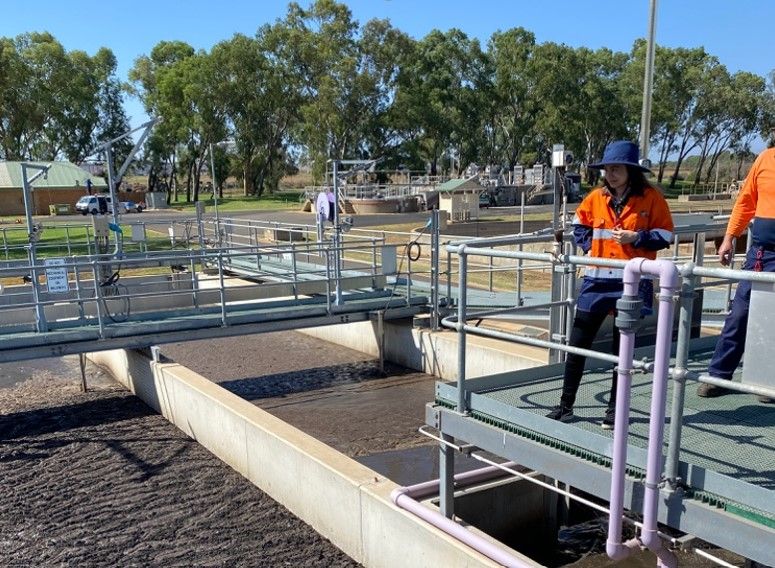Regional NSW water use study finds potential water savings of 21%

Introduction
In October 2020, Smart Approved WaterMark (SAWM) was engaged by the NSW Department of Planning Industry and Environment (DPIE) to conduct fieldwork to identify potential water efficiency opportunities in 12 water supply systems across 6 Local Water Utilities (LWUs) in the Murray Darling Basin. The focus for this fieldwork was placed on network and non-residential customer opportunities. The 6 LWUs shortlisted and their respective water supply systems assessed were Central Darling Shire Council, Dubbo Regional Council, Leeton Shire Council, Murray River Council, Parkes Shire Council and Essential Energy in Broken Hill.
Fieldwork
The fieldwork formed part of the ‘Local Water Utility Water Efficiency Measures Feasibility Study’ which aimed to identify the potential for NSW Local Water Utilities (LWUs) within the NSW Murray-Darling Basin to achieve water savings through urban water efficiency projects. Smart Approved WaterMark in association with Adam Jones at BMT and Reid Butler at REID environmental – both SAWM accredited suppliers - conducted the site visits throughout November and December 2020.
Identifying network opportunities was a complex balance of:
- Reviewing IWCM Issues papers, Water Loss Management Plan reports (as available), Demand Management Plans and any other provided information;
- Meeting with Council staff to discuss water loss issues and potential opportunities;
- Visiting sites with known leakage issues, past operational problems or opportunities to ground truth the scale of the water use;
- Gathering any data or information about investigations into projects LWU staff have considered that could deliver water savings and could be considered for progression as a feasible project;
- Researching industry knowledge for other similar projects and issues;
- Compiling estimates of water savings.
Identifying non-residential customer opportunities involved:
- Conducting initial research into the spread of businesses in the various LWU areas. Common sectors were found to include accommodation providers, hospitals, aged care facilities, schools, childcare centres, gyms, pools, office buildings, retail and food services.
- Reviewing the available customer water use data provided. This step was intended to provide a ‘long list’ for targeting of specific businesses.
- Seeking feedback from local water utility operators.
- Contacting sites, arranging a site meeting and walk through inspection to look at all key water use areas.
- Reviewing information on site water use and past actions.
- Conducting site meetings and walk throughs of key water use areas to identify any immediate opportunities. This included visiting plant areas, measuring flowrates in bathroom and kitchen areas, meeting with various staff and recording details on potable water use. Additionally, for each site there was a discussion with site staff about water efficiency opportunities, barriers and incentives.
- A total of 58 sites were visited, including 26 Large Sites, 10 Council Sites (excluding network sites such as treatment plants and pump stations, and discussions about parks portfolios), 22 Small Sites
Fieldwork findings
The findings of this project suggest several opportunities for deploying water efficiency measures in LWUs across the whole of the Murray-Darling Basin. The fieldwork analysis of non-residential sites visited in the six case study areas (53 in total) identified an average potential water saving of 21%, with a simple payback period of 3.3 years based on current water prices. The fieldwork findings provided further evidence of the need for improved network metering and monitoring to enable the reduction of network losses, with various potential projects identified that the case study LWUs could consider progressing.
The fieldwork findings were placed into a systems level water efficiency calculator developed by the Institute of Sustainable Futures to enable extrapolation across 21 LWUs. When analysing the set of 21 LWUs using the water efficiency calculator , most of the LWUs exhibited overall average savings of between 5% and 20%, with the average saving across all 21 LWUs being around 13%. The 6 case studies provided further in-depth analysis based on field visits and engagement with the LWUs, and costs and water savings were estimated for the identified opportunities.
The findings of this project suggest several opportunities for deploying water efficiency measures in LWUs across the whole of the Murray-Darling Basin. The opportunities identified through this project include:
- Understanding of LWU’s water saving opportunities achieved through conducting a water efficiency study for a specific LWU area.
- Installing enabling technology through the establishment of demand management areas (DMAs), upgrading of the metering and telemetry, the monitoring of the collected data, and the timely repairing of leaks would see the current levels of system water losses reduced.
- A network leakage program would provide economies of scale and simplify procurement for the roll out of active leakage detection programs.
- Large and major water customer programs would provide enabling support to those large customers who may choose to pursue water efficiency improvements where they can see a return on investment.
- Residential programs such as household retrofit and rebate programs, which might be best co-ordinated as a state-wide program together with other state institutions.
The project formed part of the NSW Government’s commitment to support the delivery of water recovery through State-led efficiency measures under the Murray-Darling Basin Water Efficiency Program (MDBWE Program). The MDBWE Program was agreed at the Murray-Darling Basin Ministerial Council meeting on 18 June 2018 and aims to deliver on the commitment to efficiency measures of an additional 450 gigalitres (GL) of environmental water to improve environmental outcomes.